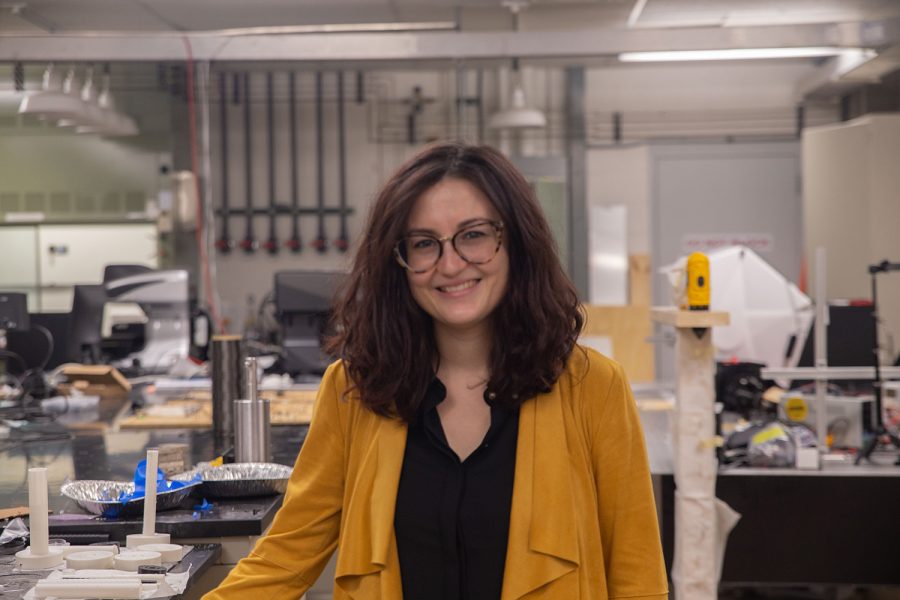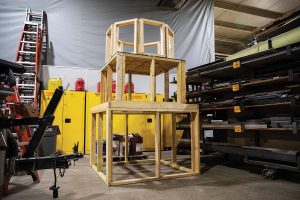UI researchers make artificial muscles with grant
Caterina Lamuta, assistant professor in Mechanical Engineering, is creating artificial muscles based on tentacle-like limbs.
Assistant Professor of Mechanical Engineering Caterina Zamuta poses for a portrait at the Iowa Advanced Technologies Laboratories at the University of Iowa on Monday, Sept. 27, 2021.
September 28, 2021
A University of Iowa professor is working with grant funds to create cephalopod, or tentacle-like, muscles to improve movement in marine technology.
UI Assistant Professor of Mechanical Engineering Caterina Lamuta and her research team are making artificial muscles that emulate the movement of cephalopod limbs. When completed, the actuators — a device used to move and control a machine — will be attached to marine vehicles to improve underwater manipulation.
Lamuta recently received a Young Investigators Award from the Defense Advanced Research Projects Agency, known as DARPA, to start this project. Lamuta said the grant will last for three years, and it is not the first Lamuta has received.
Her other grants, given by the U.S. Navy’s Office of Naval Research, NASA, the National Science Foundation, and the Air Force Office of Scientific Research for a total of $2 million, according to an article on the Iowa Institute of Hydroscience and Engineering website.
In 2019, Lamuta used the funding from the Office of Naval Research to create soft smart skin, as previously reported by The Daily Iowan. Her current project will build off her previous research, as she plans to combine the already developed smart skin with artificial muscles.
“It’s just the skin that can change the shape, because in cephalopods, there are different muscles called papillae that go up and down to change the roughness,” she said about her former project. “So that the cephalopod can camouflage, or it can also change the drag while it’s swimming, so for the Navy we started with this, what we call texture modulation device.”
The fusion of both projects, she said, will result in a fully functional artificial cephalopod limb. Examples of cephalopods are octopuses, cuttlefish, and squids.
“We will make the real tentacle with all the muscle, so that when we combine this with that project, we have a real tentacle that can do manipulation and roughness change at the same time like the octopus does,” she said.
Lamuta said the artificial muscles have different functions depending on how they are embedded in the smart skin.
“So, you can get torsion, you can get compression [and] bending, so at the end, we will have a tentacle for motion and manipulation, basically,” she said. “So, it’s a soft robot that can grab stuff underwater, and then on top of this, we will add a thin skin to do roughness change.”
Parth Kotak, a UI doctoral student and researcher in Lamuta’s Smart Multifunctional Material Systems Lab, said that according to the proposal the artificial muscles of the new project are specifically tailored for shallow water robots. He said this goal is not final, however, and may change.
“With the DARPA, they’re specifically looking for autonomous, unmanned sort of robots in shallow environments and sort of the soft concept,” Kotak said. “Because of the deep sea and the shallow environment, the conditions sort of change completely.”
He said in shallow environments, robots interact more with the objects in the environment, like rocks and corrals.
“Imagine that you have to lift something, or you have to hold a camera or some equipment, and then they need something that is waterproof, that’s lightweight,” Lamuta said. “That’s why we’re making this soft robot for underwater application.”
The UI research team’s actuators are unique, she said, because they do not require high voltage input to work so do not have to carry heavy power supplies. This makes the product portable, she said.
Lamuta added that they are making various artificial muscles with different materials and capacities.
“The one that we made from carbon fiber and silicon rubber, they can lift up to 12,600 times their own weight,” she said.
The polymer fiber products, on the other hand, can lift a bit less but within the same range, Lamuta added. Still, each variant is a combination of lightweight and strong, she said.
Lamuta said she gained curiosity about cephalopods only after she began on her Navy project in 2019. She said it was a YouTube video of an octopus that sparked the idea for the smart skin modulation and eventually for the soft actuators.
Lamuta said she always knew she wanted to be a researcher, but it was not until high school that she realized she liked engineering.
Kotak, on the other hand, said his passion for engineering goes back to his early childhood.
“I was really obsessed with rockets as a kid, and that’s what I started off with in high school and then in undergrad, and then in undergrad — the first year — I actually built a bunch of motor pressure rockets,” he said. “But then I realized that I wanted something more broad, so then I switched to become a mechanical engineer.”
Lamuta said the team hopes to have a complete, functional artificial underwater octopus within the next year and a half, which marks the end of Kotak’s Ph.D.
“[The project is in] a very preliminary stage,” Kotak said. “We’re still sort of perfecting our artificial muscles, and then once we perfect the muscles, we go into assembling the actual tentacle.”






